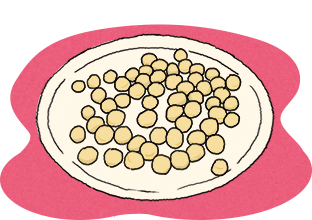Everything You Need to Know about GI
Professor
Laboratory of Nutrition, Department of Food Science Dean Faculty of Home Economics, Otsuma Women's University

GI, or glycemic index, is an indicator of how much your blood glucose level rises after a meal.
GI is an abbreviation of the term "glycemic index" and is an indicator of how much your blood glucose level rises after a meal. In other words, it indicates how much of the sugar contained in foods are absorbed and is a measure of how much of that sugar is in your bloodstream up to two hours after you eat.
Foods with a GI value of 70 or higher are defined as high GI foods, foods between 56 and 69 as medium GI foods, and those with less than 55 are defined as low GI foods, when using glucose as the reference food (where glucose = 100) according to the University of Sydney.
GI first began to attract attention in the 1990s and was the subject of an FAO/WHO report in 1998. In 2003, the WHO issued a report stating that low GI foods had the potential to reduce the risk of being overweight, obesity, and type 2 diabetes. Following that, a variety of studies were carried out, resulting in an increased demand for low GI foods, which contain high fiber and have a low energy density.
Low GI foods have drawn a lot of attention because they are associated with the improvement and prevention of obesity and metabolic syndrome, two conditions that more and more people suffer from nowadays.
- Fasting blood sugar level 99mg/dL
(Japan Society of Ningen Dock) - Postprandial blood sugar level (2 hours after eating) 7.8mmol/L (140mg/dL)
(International Diabetes Federation)
Foods with a GI value of 70 or higher are defined as high GI foods, foods between 56 and 69 as medium GI foods, and those with less than 55 are defined as low GI foods, when using glucose as the reference food (where glucose = 100) according to the University of Syndey.
Learn more about GI
- Protect Yourself From Heat Disorders
- Preventing Traveller's Thrombosis (Economy Class Syndrome)
- Menopause lab (Japanese)
- Living well with menopause
- PMS lab (Japanese)
- men-eki navi (website about "immunity", in Japanese only)
- AMP helps the renewal of skin cells (Japanese)
- Sleep Rhythm Lab (Japanese)
- The surprising facts about dietary fiber
- Everything You Need to Know about GI
- Jump start your brain with a well-balanced breakfast
- Vitamins & Minerals Q&A
- BCAA Helps Maintain Exercise Performance
- Smile Navigator: Schizophrenia (Japanese)
- Smile Navigator: Bipolar disorder (Japanese)
- Smile Navigator: Depression (Japanese)
- Smile Navigator: Pediatric autism spectrum disorder (Japanese)
- Zutsuu-nayami.jp (website about "headaches", in Japanese only)
- Parkinson's Disease
- Restless Legs Syndrome
- Gen-shu.jp ("reducing alcohol consumption", in Japanese only)
- Learn about Heart Failure, its Prevention, and Treatment
- ADPKD.JP (Japanese)
- PAD: Be Careful of Changes in Your Limbs
- Liver cirrhosis nutritional therapy
- Get Your Healthy Stomach Back
- Did You Know There Are Quick Tests for Infectious Diseases?
- Do You Have Symptoms of Dry Eye?
- Decoboco eye: All about eye health (Japanese)
- Atopeace (website about "atopic dermatitis", in Japanese only)
- Acne: Are You Doing Anything About It?





